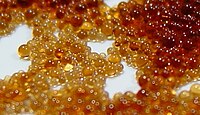
Photo from wikipedia
Pelleted preparations were formulated from sacran (Sac), an anionic, sulfated, carboxyl-containing polysaccharide, which is extracted from the Japanese indigenous cyanobacterium Aphanothece sacrum, and surface-deacetylated chitin nanofibers (SDACNF). The use of… Click to show full abstract
Pelleted preparations were formulated from sacran (Sac), an anionic, sulfated, carboxyl-containing polysaccharide, which is extracted from the Japanese indigenous cyanobacterium Aphanothece sacrum, and surface-deacetylated chitin nanofibers (SDACNF). The use of this material as an extended-release excipient for tetrahydrocurcumin (THC), a model drug that is used to treat wounds via its radical scavenging ability was examined. The THC used in the study was complexed with 2-hydroxypropyl-β-cyclodextrin (HP-β-CD), which increases its water solubility. The radical scavenging activity of the THC/HP-β-CD complex (molar ratio of 1:1) was significantly higher than the values for SDACNF or Sac alone. The rate of release of THC from the Sac/SDACNF pellets containing the THC/HP-β-CD complex decreased with increasing Sac content in the pellet, suggesting that Sac/SDACNF (1:1) and Sac alone pellets function as extended-release excipients for THC. The findings reported here indicate that this can be attributed to the ability of the Sac component to retain fluids, thus extending the effects of the drug. In view of the above experimental outcomes, i.e. wound healing efficacy, fluid absorption, retention and the extended drug release of the system indicates that this preparation, in the appropriate ratios, has the potential for use as a controlled-release drug in wound healing.
Journal Title: International journal of biological macromolecules
Year Published: 2019
Link to full text (if available)
Share on Social Media: Sign Up to like & get
recommendations!